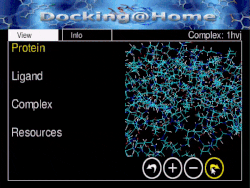 | |
| Developer(s) | University of Delaware |
|---|---|
| Operating system | Linux, macOS, and Windows [1] |
| Platform | BOINC |
| Website |
docking |
Docking@Home was a volunteer computing project hosted by the University of Delaware and running on the Berkeley Open Infrastructure for Network Computing (BOINC) software platform. It models protein- ligand docking using the CHARMM program. Volunteer computing allows an extensive search of protein-ligand docking conformations and selection of near-native ligand conformations are achieved by using ligand based hierarchical clustering. [2] The ultimate aim was the development of new pharmaceutical drugs.
The project was retired on May 23, 2014. [1]
See also
References
- ^ a b "Docking@Home is Retiring". Archived from the original on 2014-10-17. Retrieved 2014-06-15.
- ^ Estrada, Trlce; Armen, Roger; Taufer, Michela (2010-08-02). "Automatic selection of near-native protein-ligand conformations using a hierarchical clustering and volunteer computing". Proceedings of the First ACM International Conference on Bioinformatics and Computational Biology. BCB '10. New York, NY, USA: Association for Computing Machinery. pp. 204–213. doi: 10.1145/1854776.1854807. ISBN 978-1-4503-0438-2. S2CID 6040735.
Further reading
- "Computer Idle? Now You Can Donate Its Time to Find a Cure for Major Diseases". Newswise. June 16, 2009. Retrieved 2009-07-27.
External links
Wikimedia Commons has media related to
Docking@Home.